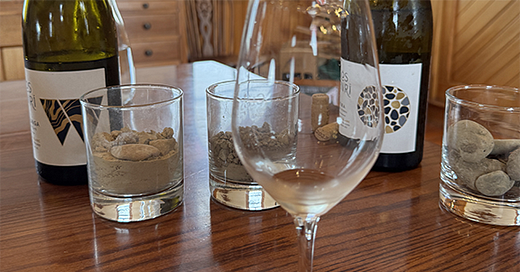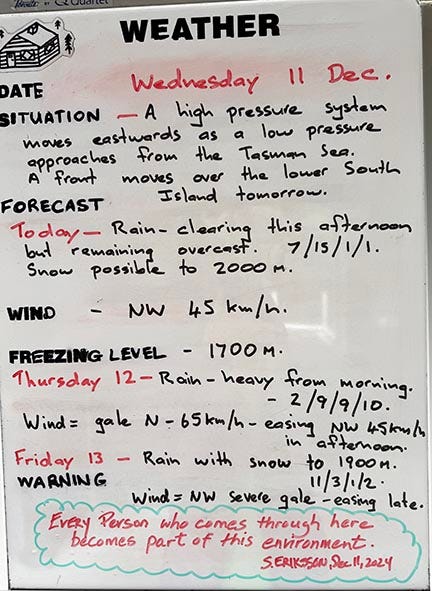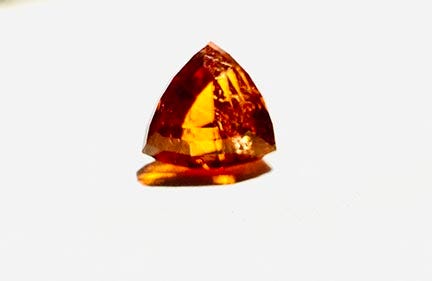From every angle, it looked like bone touching bone. I’m no expert, but when I saw the x-rays, I thought, “That can’t be good.” And sure enough, the radiologist’s report read, “Severe tricompartmental osteoarthritis.” My life as I knew it was over.
I have just returned from the culminating trip of my Jubilee Year, turning 75 on the Routeburn Track in New Zealand. From March to December 2024, I worried, I trained, I took a new drug, I bought knee braces, I walked—hoping I could do the easy part of the trek from the eastern end to the Routeburn Falls. And back again, of course.
And I did it— a relatively easy trip up the 1,800 feet in elevation change (1,300 feet up and 500 down) and a relatively difficult trip down (1,300 down and 500 feet up), over 6.8 miles each way. My daughter patiently kept my pace and regularly fed me energy gummies when I felt my battery running low. Fear of failure is a powerful motivator, and pride in one’s self is a rewarding emotion.
I usually give each vacation a theme. This trip to New Zealand into its dramatic fjordland and watery Marlborough Sound was an experiment in how I experience myself in nature. I had been focusing on myself in the Kentucky farmland of my childhood, and I was interested in thinking about my body and soul in the landscapes I experience today. I want to look forward rather than back.
When we planned the trip, my daughter and I didn’t know how hard it would be for me and my knees, so we booked two nights at the Routeburn Falls Hut with a day for me to recuperate before the hike downhill. When I checked in with John, the ranger — yes, both Katherine and I were there and had signed up for our bunk, he asked what I was planning to do on my full day at the hut. I told him I’d be happy writing and making notes, as I was a poet-wannabe and cherished the time to sit and think and play with words.
The next morning, he asked if I would like to write something for the notice board—something short and pithy. In the past few months, I’ve been referring to Wendell Berry’s writing on the environment: “The real names of the environment are the names of rivers and river valleys; creeks, ridges, and mountains; towns and cities; lakes, woodlands, lanes roads, creatures, and people.” So I wrote. “Every person who passes through here becomes a part of the environment.” John asked whether that is a positive thing. With a quick jerk of my head, I said, “I think it is.” A new concept for me, what did it mean for my body to be within the landscape
I told him of my hike to the hut, each of my 19,000 footsteps pressing down upon the soil, upon the leafy compost, against the tree root, on loose rock and outcrop jutting out of the trail. I acted upon the trail, and the trail affected me. I saw the light volcanic soil partially covered by leaves of pale brown, bright chestnut red, and dark mahogany brown. I wondered at the energy of water rushing down narrow gorges and, in the distance, the constant flow in a broad, braided stream of glacial outwash.
I told him that as I hurried across a recent slide with a sign saying “Do Not Stop.”, I reconciled this hiking experience with my long-ago lecture on mass wasting “What makes a landslide?”, checking off the saturated soil, steep slope, and added weight. I was living my lesson.
Each evening at 7, the ranger in charge of each hut on the Great Walks holds a required event, checking off each person present to ensure they aren’t hanging off a cliff somewhere along the trail and updating people on conditions on the trail for the next day– both weather and what to expect in their hike. At 2.2 pounds per liter of water, many a person appreciated the ability to fill their water bottles along a portion of the trek rather than adding 6.5 pounds to their pack.
This night, John tells us of an active fault that runs north south through the waterfall adjacent to our hut. Active as in 173,000 million years ago. Still. With rock falls, landslides, and potential flash flooding along the route, I take note. He tells the story of a hut up on the North Island that lost its moorings during an especially heavy wind and took flight with its occupants. New Zealand has no poisonous snakes or spiders but certainly has its share of earthly hazards.
Today I’m reminded that history can be obliterated in a very short period. The rewriting of the January 6 attack on our nation’s capital is happening before the very eyes that watched it. As a geologist, I have to believe there is a record left behind that will tell the true story—that’s what we count on as we look back at Earth’s history over hundreds of million, even thousands of million years. We know some parts of the record are obliterated, and some may be altered through erosion, chemical change, compaction, and other natural processes, but hopefully the many lines of inquiry with multiple pieces of evidence will lead to a story very near the truth. That’s assuming there is a truth.
Each day nudges the Earth into my latest New Zealand adventure. My driver from the Blenheim airport to Picton is steeped in the history of his whaling ancestors who migrated to New Zealand after World War II. I perked up when he told me of a vineyard with a fault running through it with volcanic soil on one side and glacially derived soil on the other. Just my kind of place.
And sure enough, I could taste the difference in the wine—the slightly fruitier sauvignon blanc on the side of nutrient- and clay-rich volcanic soil which holds water versus the minerality of the wine from the coarser, well-drained glacial soil. Of course, there didn’t need to be a fault for these two soils to lie adjacent to the other, but I ate up the story—rather I drank it in.
Why I Love this Rock
January’s birthstone is garnet - really a group of minerals although we commonly pick up a garnet and call it garnet. Specifically, this is spessartine from the Rutherford Mine in Amelia, Virginia. Find out why this one is special here.
And a Final Note this month
I was about to hit publish but have to make some sort of acknowledgement of changes in our country’s views on diversity in the workforce. I spent a good portion of my career helping the geosciences become a more inclusive science. On my website, I essentially wrote that my work here is done - geoscience has changed, and we allies can safely leave the geosciences to a more diverse community.
I’ll go in this week and modify that text.
More about Earth to Susan
I am writing a book about how people experience the Earth in different ways. I took a break but am back at the writing. In this newsletter, I’ll bring science, poetry, music, theology, literature, philosophy, history, geography, politics, and economics to these pages – all in relationship to Earth.
This month’s newsletter is how we perceive the Earth through through our own bodies, our own presence in the landscape.
I believe that helping people understand that we all see the Earth in different ways will open conversations to help find solutions for the many issues facing the planet we call home.
I hope you will continue to read this and share with your friends! It’s free.
Until next month,








Thank you. Such a treasure to read. I feel connected to the Earth as though I were there reading your writing.
This is beautiful Susan! What an adventure for you! And…as always you bring an amazing perspective to the experience.